Outdated or Unsupported Browser Detected
DWD's website uses the latest technology. This makes our site faster and easier to use across all devices. Unfortunatley, your browser is out of date and is not supported. An update is not required, but it is strongly recommended to improve your browsing experience. To update Internet Explorer to Microsoft Edge visit their website.
The purpose of this booklet is to assist doctors in evaluating permanent disability as provided for in Wisconsin Worker's Compensation statutes and administrative codes. Worker's Compensation Law provides for prompt medical care to an injured or ill worker plus benefits to help the worker meet expenses while they are out of work.
The program emphasizes a return to work as soon as possible and rehabilitation of the worker-patient both during and after the healing period. Insured employers must report injuries to their Worker's Compensation insurance carrier within seven days of any accident which causes more than three days of disability.
A medical report verifying details of the injury or illness is made part of the record for each claim. This doctor's report is very important because it is used by self-insured employers, insurance carriers and the WC Division to determine eligibility for compensation. The Medical Report on Industrial Injury (Form WKC-16) is used to determine the amount of WC benefits paid to replace lost wages and medical expense coverage. The doctor's role also is vital in determining the amount of compensation for permanent, partial disability that may be involved.
The sooner a needed medical report is available, the sooner appropriate benefits can be paid. The WKC-16 must be filed in any case when the temporary disability exceeds three weeks or if there is permanent disability or surgery performed as a result of the injury. If the employer or insurance carrier files a narrative report in place of the WKC-16, it should list any surgery and address the issue of permanent disability. The report is due from the self insured employer or insurance carrier within 30 days of the final payment of compensation, the Division must receive an explanation if it will be delayed.
To help doctors understand worker's compensation, several documents besides this one may be ordered from the Worker's Compensation Division, P.O. Box 7901, Madison, WI 53707.
WKC-7760: Guide for Wisconsin Doctors, Using the WKC-16B for Worker's Compensation.
In addition, the State Medical Society of Wisconsin publishes a form to assist doctors entitled: Attending Physician's Return to Work Recommendations Record. This will help doctors explain special limitations such as temperature extremes, contact with skin irritants, and visual and hearing problems the patient will face at work.
The evaluation of disability of an injured or ill worker is a necessary part of the patient’s treatment, and as such is a combination of both art and science. The final rating of the patient’s disability should be the medical opinion of the doctor.
Doctors may consult rating guides on relative percentage of disability and apply more than one rating formula, but in the end the final rating will be based on the doctor’s personal knowledge, experience and weighing of all anatomical damages and clinical findings.
Some elements of disability, such as range of motion, can be measured with some degree of objectivity. Here there are questions requiring exercise of professional judgment. Doctors must ask: Is the demonstrated motion by the patient consistent with the nature of the injury, the x-rays, tests and other objective findings? Is the motion consistent upon repeated testing?
Other elements of disability are more subjective and less capable of being measured precisely. Pain is a good example. There is no question that pain can be disabling. Pain is not easily measured, and judgment is required. Doctors must ask:
In its Manual for Orthopedic Surgeons in Evaluating Permanent Physical Impairment, the American Academy of Orthopedic Surgeons suggests the following guidelines in the evaluation of pain:
Grading of Pain as a Subjective Symptom
Grade I - Mild: When there is a firm conviction established through thorough observation and clinical tests that pain actually exists even though there may be no organic manifestations. Pain of this degree does not contribute to physical impairment.
Grade II - Moderate: When the examination reveals the definite evidence of a pathological state of the involved structures that would reasonably produce the degree of pain indicated to be present. This degree of pain might require treatment and could be expected to contribute in a minor degree to permanent physical impairment.
Grade III - Severe: When the pathological changes and clinical findings indicate that permanent physical function is limited by pain requiring treatment for relief and contributing extensively to permanent physical impairment.
Grade IV - Very Severe: When the pathological changes and clinical signs indicate limitation of physical function by pain to such a degree that physical impairment is nearly complete.
While pain is probably the most frequent subjective complaint, a similar reasoning process is necessary in judging other elements of disability. Examples are loss of strength, lack of endurance, loss of sensation and sensitivity to heat or cold.
It is very important for doctors to understand the distinction between "disability" in a "workplace sense" and "impairment." In evaluating disability, this is very significant. The American Medical Association and the American Academy of Orthopedic Surgeons have recognized the distinction as follows:
"1. Permanent disability is not a purely medical condition. A patient is 'permanently disabled' or 'under a permanent disability' when his (or her) actual or presumed ability to engage in gainful activity is reduced or absent because of 'impairment' and no fundamental or marked change in the future can be expected.
2. Permanent impairment is a purely medical condition. Permanent physical impairment is any anatomical or functional abnormality or loss after maximum medical rehabilitation has been achieved, which abnormality or loss the physician considers stable or non-progressive at the time evaluation is made."
AMA GUIDE: Journal of American Medical Assoc.
Some idea of this important difference can be gleaned from the fact that the AMA guidelines evaluate a blind person as having an 85 percent impairment of the whole person, while the Worker's Compensation Law states the disability is 100 percent of permanent, total disability.
The Worker’s Compensation Act establishes a schedule of allowances of weeks of compensation to be paid for amputation of the extremities (arms and legs) or any parts of the extremities, plus loss of vision or hearing. Doctors should evaluate loss of use that is less than total amputation as a percentage of total loss. This type of injury is referred to as a SCHEDULED INJURY, and is covered by Section 102.52 of the Wisconsin Statutes.
The first section of rule DWD 80.32 states:
"The disabilities set forth in this section are the minimums for the described conditions. However, findings of additional disabling elements shall result in an estimate higher than the minimum. The minimum also assumes that the member, the back, etc. was previously without disability. Appropriate reduction shall be made for any preexisting disability. Note: An example would be where, in addition to a described loss of motion, pain and circulatory disturbance further limits the use of an arm or a leg."
At times disabilities based on loss of motion may not fall exactly within the standards established in the rule, but can be interpolated fairly easily from the standards. For example, shoulder injury with limitation of active elevation and abduction to 90 degrees represents a 20 percent loss of use at the shoulder under the rule. (See #7, "Shoulder.") Limitation to 135 degrees is a 5 percent loss of use. If, in an actual sense, the patient's limitation was 120 degrees, the evaluation might well be a 10 percent loss of use.
The rest of the rule, (#2 through #14) follows:
DWD 80.32 Permanent disabilities. Minimum percentages of loss of use for amputation levels, losses of motion, sensory losses and surgical procedures. The disabilities set forth in this section are the minimums for the described conditions. However, findings of additional disabling elements shall result in an estimate higher than the minimum. The minimum also assumes that the member, the back, etc., was previously without disability. Appropriate reduction shall be made for any preexisting disability.
Note: An example would be where in addition to a described loss of motion, pain and circulatory disturbance further limits the use of an arm or a leg. A meniscectomy in a knee with less than a good result would call for an estimate higher than 5% loss of use of the leg at the knee. The same principle would apply to surgical procedures on the back. The schedule of minimum disabilities contained in this section was adopted upon the advice of a Worker's Compensation Advisory Council subcommittee after a survey of doctors experienced in treating industrial injuries.
II. Amputations, upper or lower extremities
At functional level Equivalent to amputation at mid point
Stump unsuitable to Equivalent to amputation at
accommodate prosthesis next most proximal joint
Stump not functional Grade upward
All ranges of joint motion or degrees of ankylosis not listed below are to be
interpolated from existing percent of disability listed.
III. Hip
Ankylosis, optimum position,
generally 15°
to 30° flexion 50%
Mal position Grade upward
To compute disabilities for loss
of motion relate % of motion lost
to average
range
Shortening of leg (no
posterior or lateral angulation)
No disability for shortening
less than 3/4 inch
3/4 inch 5%
1 inch 7%
1 -1/2 inches 14%
2 inches 22%
Greater than 2 inches of
shortening results in greater
proportionate rating than above
Prosthesis Total Minimum of 40%
Partial 35%
IV. Knee
Ankyiosis, optimum position, 170° 40%
Remaining range,
180°¸ - 135° 25%
Remaining range,
180°¸ - 90° 10%
Prosthesis Total 50%
Partial 45%
Removal of patella To be based on functional impairment
Total or partial meniscectomy (open or closed procedure)
Excellent to good result 5%
Anterior cruciate ligament
repair Minimum of 10%
V. Ankle
Total ankylosis, optimum
position, total loss of motion 40%
Ankylosis ankle joint
Loss of dorsi and planter flexion 30%
Subtalar ankylosis
Loss of inversion and eversion 15%
Vl. Toes
Ankylosis great toe at proximal joint 50%
All other toes at proximal 40%
Ankylosis great toe at distal joint 15%
All other toes at any If no deformity, no disability
interphalangeal joint
Mal position On merits
Loss of motion No disability
VII. Shoulder
Ankylosis, optimum position,
scapula free 55%
In mal position Grade upward
Limitation of active elevation in
flexion and abduction to 45°
but otherwise normal 30%
Limitation of active elevation in
flexion and abduction to 90°
but otherwise normal 20%
Limitation of active elevation in
flexion and abduction to 135°
but otherwise normal 5%
Prosthesis 50%
VIII. Elbow
Ankylosis, optimum
position, 45°¸ angle
With radio-ulnar
motion destroyed 60%
With radio-ulnar
motion intact 45%
Rotational ankylosis in
neutral position 20%
Any mal position Grade upward
Limitation of motion
elbow joint,
radio-ulnar motion
unaffected
Remaining range -
180° - 135° 35%
Remaining range -
135° - 90° 20%
Remaining range -
180°- 90° 10%
Rotation at elbow joint
Neutral to full pronation 10%
Neutral to full supination 15%
IX. Wrist
Ankylosis, optimum position
30° dorsiflexion 30%
Mal position Grade upward
Total loss dorsiflexion 12 1/2%
Total loss palmarflexion 7 1/2%
Total loss inversion 5%
Total loss eversion 5%
X. Complete Sensory Loss
Any digit 50% Lesser involvement to be
graded appropriately -35% for
palmer, 15% for dorsal
surface
Total median sensory loss to hand 65-75%
Total ulnar sensory loss to hand 25%
Ulnar nerve paralysis
Above elbow, sensory involvement 50% at wrist
Below elbow, motor and sensory
involvement 45-50% at wrist
Below elbow, motor
involvement only 35-45% at wrist
Below elbow, sensory
involvement only 5-10% at wrist
Median nerve paralysis
Above elbow, motor and sensory
involvement 55-65% at wrist
Thenar paralysis with sensory loss 40-50% at wrist
Radial nerve paralysis
Complete loss of extension,
elbow wrist and fingers 45-55% at shoulder
Complete loss of extension,
wrist and fingers 45-55% at wrist
Peroneal nerve paralysis
At level below knee 25-30% at knee
Xl. Back
Removal of disc material,
no undue symptomatic
complaints or any objective
findings 5%
Chymopapain injection To be rated by doctor
Spinal fusion, good results 5% minimum per level
Implantation of an artificial
spinal disc 7.5%
Removal of disc material and
fusion 10% per level
Cervical fusion, successful 5%
Compression fractures of
vertebrae of such degree to
cause permanent disability
may be rated 5% and graded upward
Note: It is the subcommittee's intention that a separate minimum 5%
allowance be given for every surgical procedure (open or closed, radical
or partial) that is done to relieve from the effects of a disc lesion or
spinal cord pressure. Each disc treated or surgical procedure performed
will qualify for a 5% rating. Due to the fact a fusion involves
2 procedures a 1) laminectomy (discectomy) and a 2) fusion procedure,
10% permanent total disability will apply when the 2 surgical procedures
are done at the same time or separately.
Examples:
Patient A 12/01/1990 Laminectomy 5% PTD
05/01/1992 Fusion increases to 10% PTD
Patient B 12/01/1990 Laminectomy & Fusion 10% PTD
05/01/1992 Re-fusion increases to 15% PTD
12/01/1992 Laminectomy at New Level increases to 20% PTD
05/01/1993 Fusion at 12/1/92 Level increases to 25% PTD
12/01/1993 Re-fusion at 5/1/93 Level increases to 30% PTD
Xll. Fingers
(a) Complete ankylosis
Thumb Mid-position Complete
Extension
Distal joint only 25% 35%
Proximal joint only 15% 20%
Distal and proximal joints 35% 65%
Carpometacarpal joint only 20% 20%
Distal, proximal and
carpometacarpal joints 85% 100%
Fingers Mid-position Complete
Extension
Distal joint only 25% 35%
Middle joint only 75% 85%
Proximal joint only 40% 50%
Distal and middle joints 85% 100%
Distal, middle and proximal joints 100% 100%
(b) Loss of Motion
Loss of Loss of Loss of Loss of
Flexion Use Extension Use
Fingers
Distal joint only 10% - 1% 10% - 2%
20% - 2% 20% - 4%
30% - 3% 30% - 6%
40% - 5% 40% - 8%
50% - 10% 50% - 15%
60% - 15% 60% - 20%
70% - 20% 70% - 30%
80% - 25% 80% - 40%
100% - 60%
Middle joint only 10% - 5% 10% - 2 1/2%
20% - 10% 20% - 5%
30% - 15% 30% - 10%
40% - 25% 40% - 15%
50% - 40% 50% - 30%
60% - 50% 60% - 50%
70% - 60% 70% - 70%
80% - 70% 80% - 90%
100% - 100%
Proximal joint only 10% - 5% 10% - 2 1/2%
20% - 10% 20% - 5%
30% - 15% 30% - 15%
40% - 20% 40% - 20%
50% - 25% 50% - 25%
60% - 30% 60% - 40%
70% - 35% 70% - 75%
80% - 40% 80% - 85%
90% - 100%
Thumb
Distal joint same as
fingers
Proximal joint 40% of
the loss of use
indicated for fingers
XIII. Kidney Loss of one kidney
5% permanent total disability.
XIV. Loss of Smell
Total loss of sense of smell
2-1/2% permanent total disability.
DWD 80.33 Permanent disabilities; fingertip amputations. In estimating permanent disability as a result of fingertip amputations, amputation of the distal one-third or less shall be considered the equivalent of 45% loss of use of the distal phalanx, amputation of not more than the distal two-thirds but more than the distal one-third shall be considered the equivalent of 80% loss of use of the distal phalanx, and amputation of more than the distal two-thirds shall be considered as 100% loss of the distal phalanx, provided there is not added disability as a result of malformed nail or tissue. In no case shall the allowance be greater than it would have been for amputation of the entire distal phalanx.
Having used the guidelines in the rule as starting points, doctors must then ask what other elements of disability are present and what would constitute an appropriate allowance. Questions doctors should ask are:
Ankylosis (the fused or frozen position) of the wrist in 30 degrees of dorsiflexion (bent up) is a 30 percent loss of use at the wrist. If an injury involves loss of palmar flexion (palm down), dorsiflexion and radial deviation, the question to be asked is how the disability compares with ankylosis in the "position of function." This is the fused position which would allow the most use, or the "most favorable" position. Is it more or less? How much more or less?
In interpolating the guidelines, it is important to remember that the first few degrees of motion from the "position of function" are more important than the degrees lost at the extremes of the normal range of motion. Motion measurements are based on active, not passive, motion. Motion may be effectively limited by pain, even though greater motion is mechanically possible.
It is virtually impossible to develop guidelines that will cover, in whole or in part, every conceivable condition. In those situations not covered, doctors must rely upon professional judgment just as that professional judgment is relied upon in treatment. There is no substitute. Patients with very similar pulmonary function tests, for example, may have markedly different degrees of dyspnea (shortness of breath). A person with Raynaud's phenomenon may have normal motion but have very limited use of the hands due to the pain produced by extended activity.
In one burn case, an attending doctor described a disability as follows:
"I restricted 'X' from working in extremes of heat and cold. This was done for two reasons. His burned skin is markedly more sensitive to heat and cold than is normal skin and will be damaged by extremes of heat and cold. Secondly, his joint stiffness will be markedly exacerbated by extremes of cold. 'X' will be left with permanent residuals from his injury which will consist of altered sensations of the skin, increased rigidity of the skin, intolerance to heat and cold and hypersensitivity to sunlight.
Obviously there is a residual industrial disability that affects the employability of this injured person. The extent of that disability must be evaluated by the doctor, relying on professional knowledge and experience. Failure to arrive at a disability rating could mean that an employee with a compensable disability is denied permanent disability benefits.
Guidelines to help doctors evaluate permanent impairment have been published by the American Medical Association and the American Academy of Orthopedic Surgery. These guides may be consulted for information and comparison purposes. They are NOT, however, to be the basis for evaluation; the schedules are to be used for that purpose. The AMA and AAOS guides evaluate impairment, not disability. This may not be as significant as it appears since similar physical conditions result in very comparative percentage evaluations in some instances. Examples are:
AMA AAOS DWD 80.32 Total ankylosis of the ankle 40% 40% 40% Excision of cervical disc 5% 10% 5% Ankylosis of wrist at 30 degrees dorsiflexion 25% 35% 30%
An employer or its insurer is not liable for any pre-existing disability clearly shown to exist. Employers take responsibility for injured workers as they find them. If workers are more susceptible than normal to injury because of a pre-existing condition, the employer is nevertheless liable for the effects of the injury. An employer is liable to the extent that an injury aggravates and accelerates a pre-existing condition.
Permanent total disability (PTD) means complete disability for industrial or other employment-related purposes, although the individual may be able to perform functions not related to work, such as self care, quite satisfactorily. PTD is defined in sec. 102.44(2) of Wisconsin Statutes as:
"Total impairment for industrial use of both eyes, or the loss of both arms at or near the shoulder, or of both legs at or near the hip, of one arm at the shoulder and one leg at the hip..." The Statute then goes on to say: "This enumeration is not exclusive, but in other cases the department [DWD] shall find the facts."
In determining what standard is to be applied "in other cases" under the statute, DWD and the Wisconsin Supreme Court have determined that:
"An employee who is so injured that he (or she) can perform no services other than those which are so limited in quality, dependability, or quantity that a reasonably stable market for them does not exist, may well be classified as totally disabled." (Balczewski vs. DILHR, 76 Wis. 2d 487, 493.)
A primary purpose of Worker's Compensation is returning the injured or ill worker as soon as possible to productive employment, and the doctor's evaluation plays a major role in this goal.
Performing restricted work, with limits on how many pounds can be lifted or how often bending can occur, for example, facilitates return to work at the end of a healing period. When the doctor specifies the patient's capacities and abilities, as well as restrictions (either temporary or permanent) it benefits the injured worker, the employer and the insurer.
Capacities and restrictions need to be defined in terms of time periods (i.e., two hours per day for one week followed by... etc.). Patients need to know how such recommendations affect their activities while away from the workplace, as well.
If it is the doctor's opinion that a patient will not be able to perform the former job permanently, this recommendation should also be explained and reported. Then the vocational rehabilitation process can be initiated. This recommendation should be reflected in the percentage of permanent disability assigned to the case.
However, if a recommendation for a permanent job change is recognized before the amount of permanent disability is assigned, the recommendation should be made immediately, before the end of the healing period, as well as when assigning permanent disability.
The final section of this booklet provides doctors with a ready reference on the average range of motion in the various joints. This information is important to properly evaluate permanent disability in work-related accidents cases. DWD is indebted to the Wausau Insurance Companies for allowing the state to use their drawings. They are reprinted with permission.
To properly evaluate permanent disabilities in industrial cases, it is necessary to know the average range of motion in the various joints. A review of the literature is confusing because of the lack of standard methods of measurement.
The average motion at a given articulation must be used as the normal, since there is considerable variation dependent upon age and individual characteristics. In industrial work, the degree of motion in the affected joint should always be compared with that of the opposite joint whenever possible.
All motions should be measured from a neutral point, and the angles
measured with a goniometer or a protractor.
Each arc of the range of a circle is not of equal importance from the standpoint of function. The motion in forward elevation and abduction at the shoulder is more important than adduction and backward elevation. In the knee and elbow, the completion of flexion is not of as much importance as the first 45° of motion. In the ankle a few degrees of dorsiflexion is much less disabling than the absence of dorsiflexion. The loss of the last few degrees of motion in most joints constitutes very little, if any industrial disability.
HINGE MOTION - open at least one inch, closed to proper occlusion. Retrusion - 1/16 inch, protrusion - 1/4 inch. Rotation through a vertical or transverse axis - 1/4 inch from midline.
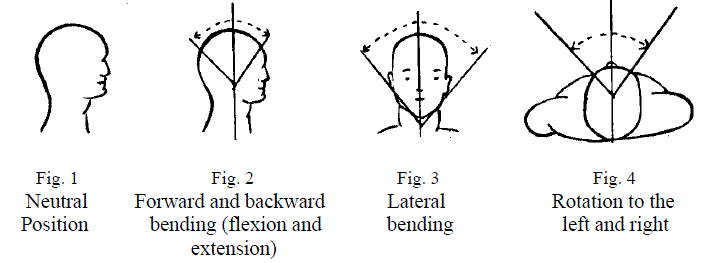
NEUTRAL POSITION - HEAD UP AND CHIN IN.
When we nod the head in assent, we are seesawing the skull on the runners of the atlas joint, like a rocking chair on a tipcart. If the head is rotated from side to side in denial, it is being turned on the pivot joint between the atlas and the axis, as on a rotating platform.
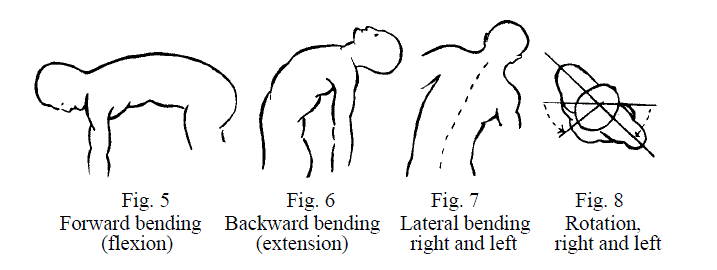
NEUTRAL POSITION - spine in perpendicular position.
Motion in the spine is hard to evaluate because of its compound nature. The cervical and lumbar regions are freely movable, while motion in the thoracic spine is quite limited. Forward bending is extremely variable, and depends upon the patient's general physique, habits of exercise, laxity or contracture of the hamstring muscles, etc. On forward bending it should be noted whether the lumbar spine flattens or reverses itself. Marked loss in forward bending in the lumbar region is important.
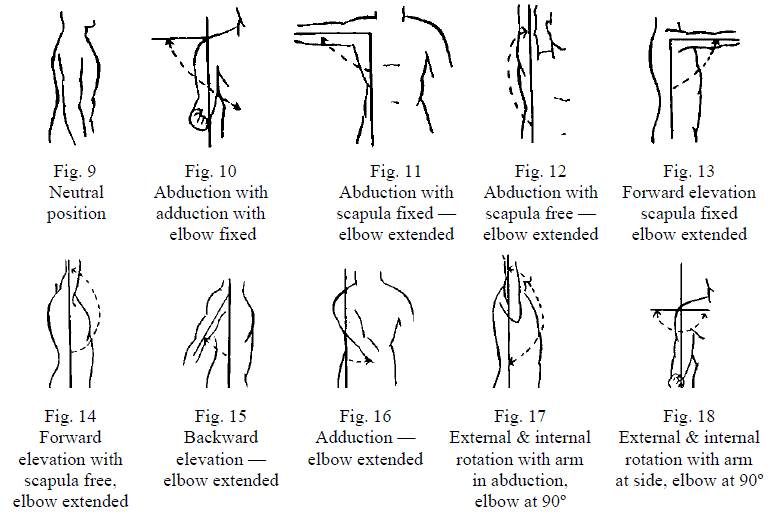
NEUTRAL POSITION - arm at the side with humerus in the lateral plane of the body and elbow extended. Since the arm is pointing to 6 o'clock on a circle, the starting point is one of 180°.
Motions of the arm at the shoulder are accomplished through the scapula, as well as through the glenohumeral joint. With fixation of the arm at the side, the forearm and hand can only function in the sagittal plane. When the scapular motion is free, the disability is much less. Complete ankylosis at the glenohumeral joint, with the arm in the optimum functional position of abduction and forward elevation, and with the scapula free, still gives a very useful range of motion.
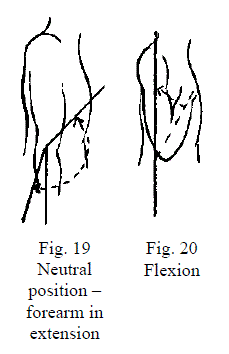
HINGE MOTION
NEUTRAL POSITION - forearm in extension
With the elbow fixed in marked or complete extension, the wrist and hand are rendered proportionally useless. The carrying angle of the elbow is the angle at the long axis of the humerus and the long axis of the forearm. The average is about 15°.

NEUTRAL POSITION - elbow flexed at 90° and forearm midway between pronation and supination (forearm at the vertical)
The radius may be regarded as the main bone of the forearm and wrist, just above the distal end of the radius, and on the inner side of the bone, there is an articular surface known as the sigmoid cavity. This is for articulation with the distal end of the ulna. The distal portion of the ulna also has a lateral articular facet. This joint permits the radius to rotate around the ulna through an arc of about 140°, the hand and the fibrocartilage moving with the radius.
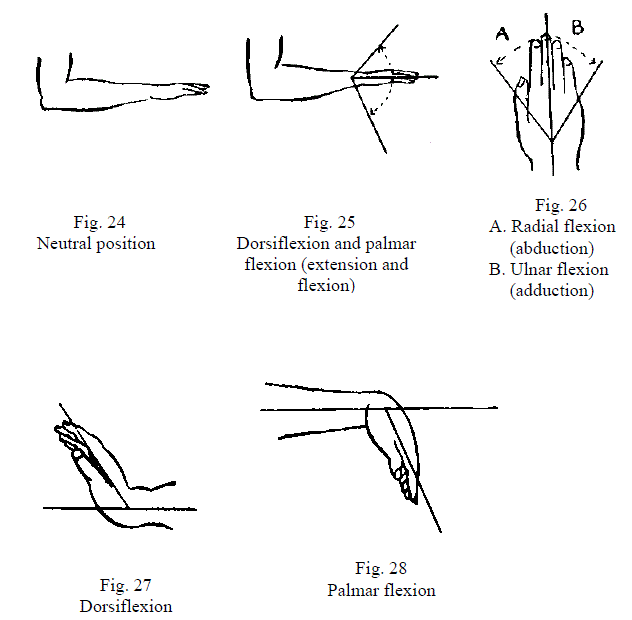
NEUTRAL POSITION - Hand in line with forearm with palm facing downward
Abduction and adduction of the wrist occur almost entirely at the radio-carpal joint. Flexion and extension are also largely at this joint. The position of strength in the hand is one of moderate dorsiflexion. As the angle of dorsiflexion is lost, the flexion power of the fingers is diminished.

NEUTRAL POSITION - thumb alongside forefinger and extended.
The trapezium-metacarpal joint is theoretically a part of the wrist, but its motions are, within certain limits, independent of the wrist. Abduction of the thumb, when limited, is perhaps best measured by taking the distance from the proximal joint of the index finger to the tip of the thumb in abduction and comparing it with the opposite side. One of the main functions of the hand is the grasping power between the thumb and the fingers. Loss of motion, particularly in the thumb, which interferes with this, is therefore of extreme importance. Ankylosis of the thumb in the grasping position is less disabling than loss of motion which does not permit grasping.

NEUTRAL POSITION - fingers in extension
In the fingers, the metacarpophalangeal joint plays an important role. Limitation of motion affects the entire finger in normal closure of the hand.
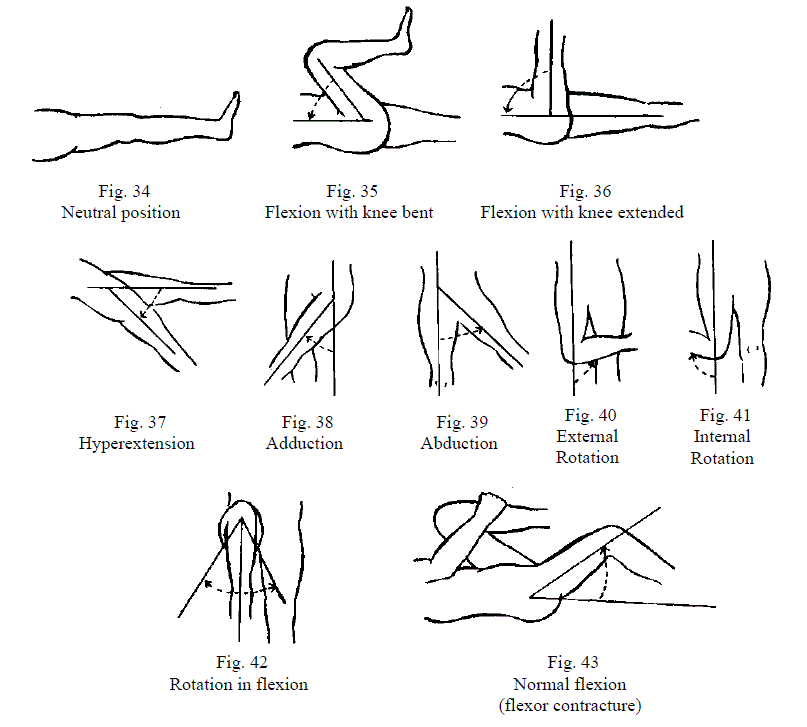
NEUTRAL POSITION - hip and knee in extension, patella pointing forward
Flexion at the hip, with the knee extended, varies considerably with different individuals, and will depend upon the amount of laxity or contracture of the hamstring tendons. Stiffness in the hips is compensated for throughout the lumbar spine. The greater the flexion deformity is, the greater the disability

HINGE MOTION
NEUTRAL POSITION - complete extension, 180°

NEUTRAL POSITION - Outer border of the foot at 90° with leg and in neutral, as regards inversion and eversion.
Complete ankylosis at the ankle still leaves considerable motion in the foot. Motion of even a few degrees dorsiflexion is much less disabling than if this is entirely lost.
The subastragalar joint contributes a considerable amount of lateral motion in the use of the foot.
The calcaneal-astragaloscaphoid joint allows a twisting rotation to the foot. The astragalus is the fixed point and the anterior part of the foot is moved. In pronation the head of the astragalus rolls inward and downward in the socket of the scaphoid.
The mid-tarsal joints have as their chief movements, abduction and adduction of the anterior part of the foot.
The metatarsophalangeal joints contribute very little motion to the foot.
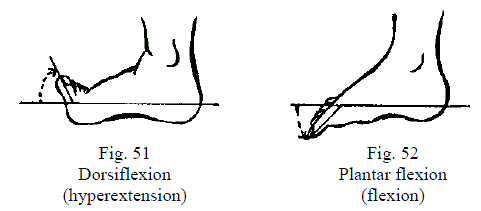
NEUTRAL POSITION - with the toes parallel to the foot.
Motions cannot be accurately measured. These motions are best described by comparing their limitations with the opposite side, also as to whether the motions are abnormally free or restricted.
The metatarsophalangeal joint is particularly important in the great toe. Stiffness in this joint, especially in dorsiflexion, is disabling insofar as forward propulsion of the foot is concerned.
(When a joint is ankylosed in flexion, the degree is important. It is best to describe such a deformity in terms of a flexor contracture or permanent flexion.)
When it becomes necessary to immobilize a joint, this should be placed in the so-called position of election, unless for some reason this is contra-indicated. These positions are those which allow for the greatest function in the member if ankylosis should occur, the only exception being that of the foot at the ankle.
These positions, briefly, are as follows:
WKC-7761-P (R. 10/2024)